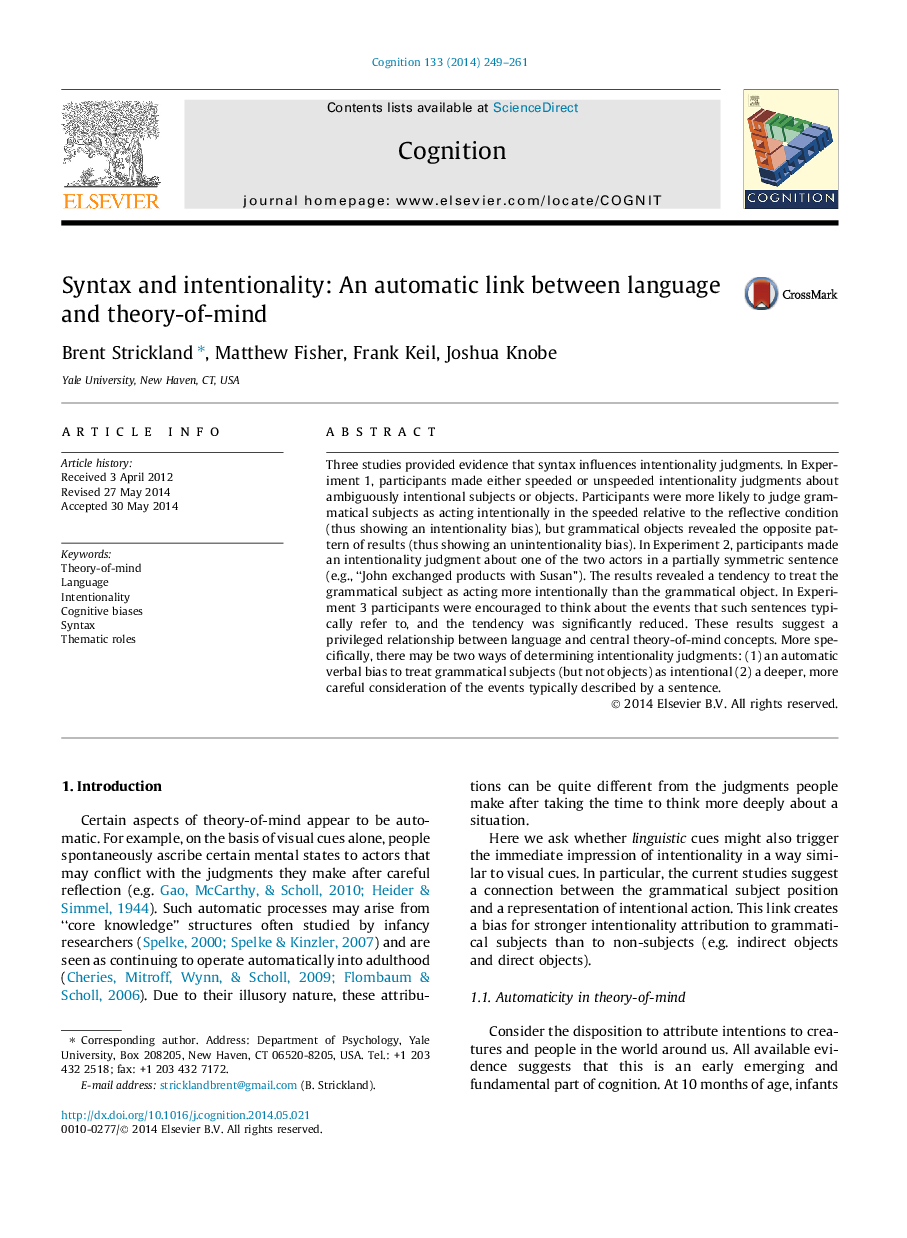| کد مقاله | کد نشریه | سال انتشار | مقاله انگلیسی | نسخه تمام متن |
|---|---|---|---|---|
| 10457737 | 921887 | 2014 | 13 صفحه PDF | دانلود رایگان |
عنوان انگلیسی مقاله ISI
Syntax and intentionality: An automatic link between language and theory-of-mind
ترجمه فارسی عنوان
نحو و قصد: پیوند خودکار بین زبان و تئوری ذهن
دانلود مقاله + سفارش ترجمه
دانلود مقاله ISI انگلیسی
رایگان برای ایرانیان
کلمات کلیدی
نظریه ذهن، زبان، اندیشه تعصب شناختی، نحو، نقش های موضوعی،
ترجمه چکیده
سه مطالعه شواهدی ارائه دادند که نحو بر قضاوت های عمدی تأثیر می گذارد. در آزمایشی 1 شرکت کنندگان قضاوت های عمدی یا غیرمستقیم درباره موضوعات یا اشیاء مبهم عمدی انجام دادند. شرکت کنندگان احتمال بیشتری برای قضاوت در مورد گرامر به عنوان عمدی اقدام به سرعت در مقایسه با شرایط بازتابنده (به این ترتیب نشان دهنده یک تعصب عمدی) هستند، اما اشیای گرامری الگوی متضاد نتایج را نشان می دهد (به طوری که نشان می دهد افسردگی ناخواسته). در آزمایش 2، شرکت کنندگان یک قضاوت عمدی درباره یکی از دو بازیگر در یک جمله تقریبا نیمه متقابل (به عنوان مثال، جان مبادله محصولات با سوزانا) انجام دادند. نتایج نشان داد که تمایل به درمان موضوع گرامری را به عنوان قسمتی از قاعده دستوری انجام داده است. در آزمایش 3، شرکت کنندگان تشویق به فکر کردن درباره حوادثی بودند که به طور معمول به این جملات اشاره می شد و گرایش به طور قابل توجهی کاهش می یافت. این نتایج نشان می دهد که رابطه ویژه بین زبان و مفاهیم تئوری ذهن مرکزی است. به طور خاص، ممکن است دو راه برای تعیین قضاوت های عمدی وجود داشته باشد: (1) یک تعصب کلامی خودکار برای درمان موضوعات دستوری (اما نه اشیاء) به صورت هدفمند؛ (2) درک عمیق تر و دقیق تر از رویدادهایی که معمولا توسط یک جمله بیان می شود.
موضوعات مرتبط
علوم زیستی و بیوفناوری
علم عصب شناسی
علوم اعصاب شناختی
چکیده انگلیسی
Three studies provided evidence that syntax influences intentionality judgments. In Experiment 1, participants made either speeded or unspeeded intentionality judgments about ambiguously intentional subjects or objects. Participants were more likely to judge grammatical subjects as acting intentionally in the speeded relative to the reflective condition (thus showing an intentionality bias), but grammatical objects revealed the opposite pattern of results (thus showing an unintentionality bias). In Experiment 2, participants made an intentionality judgment about one of the two actors in a partially symmetric sentence (e.g., “John exchanged products with Susan”). The results revealed a tendency to treat the grammatical subject as acting more intentionally than the grammatical object. In Experiment 3 participants were encouraged to think about the events that such sentences typically refer to, and the tendency was significantly reduced. These results suggest a privileged relationship between language and central theory-of-mind concepts. More specifically, there may be two ways of determining intentionality judgments: (1) an automatic verbal bias to treat grammatical subjects (but not objects) as intentional (2) a deeper, more careful consideration of the events typically described by a sentence.
ناشر
Database: Elsevier - ScienceDirect (ساینس دایرکت)
Journal: Cognition - Volume 133, Issue 1, October 2014, Pages 249-261
Journal: Cognition - Volume 133, Issue 1, October 2014, Pages 249-261
نویسندگان
Brent Strickland, Matthew Fisher, Frank Keil, Joshua Knobe,
